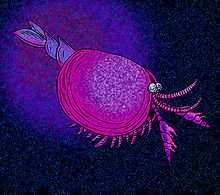Megacheira
| Megacheira Temporal range: Cambrian Stage 3–Early Devonian | |
|---|---|
 | |
| Occacaris | |
| Scientific classification | |
| Kingdom: | Animalia |
| Phylum: | Arthropoda |
| Clade: | Arachnomorpha |
| Class: | †Megacheira Hou and Bergstrom, 1997 |
Megacheira ("Great Hands") is an extinct class of predatory euarthropods that possessed a pair of short enlarged appendages[1] (the source of the class' name). They strongly resemble early chelicerates.[2][3][4] Most of them were found in marine environments throughout the world from the lower to middle Cambrian; however, the group also contains one species (Enalikter aphson) described from the Silurian Herefordshire Lagerstätte of the United Kingdom, and one species (Bundenbachiellus giganteus) known from the Early Devonian of Germany.[5] They were important components of several faunas, including the Burgess, Wheeler and Maotianshan Shales lagerstattens. Genera referred to the class include Leanchoilia, Alalcomenaeus and Yohoia, Fortiforceps and Jianfengia.
External links
- ↑ Stein, Martin (March 2010) [26 February 2010]. "A new arthropod from the Early Cambrian of North Greenland, with a 'great appendage'-like antennula". Zoological Journal of the Linnean Society 158 (3): 477–500. doi:10.1111/j.1096-3642.2009.00562.x. (subscription required (help)).
- ↑ Stolte, Daniel (16 October 2013). "Extinct 'Mega Claw' Creature Had Spider-Like Brain". University of Arizona.
- ↑ "Extinct 'mega claw' creature had spider-like brain" (Press release). ScienceDaily. 16 October 2013.
- ↑ Tanaka, Gengo; Hou, Xianguang; Ma, Xiaoya; Edgecombe, Gregory D.; Strausfeld, Nicholas J. (17 October 2013). "Chelicerate neural ground pattern in a Cambrian great appendage arthropod". Nature 502 (7471): 364–367. doi:10.1038/nature12520. PMID 24132294. (subscription required (help)).
- ↑ Siveter, Derek J.; Briggs, Derek E. G.; Siveter, David J.; Sutton, Mark D.; Legg, David; Joomun, Sarah (7 March 2014). "A Silurian short-great-appendage arthropod". Proceedings of the Royal Society B 281 (1778): 20132986. doi:10.1098/rspb.2013.2986. PMID 24452026.